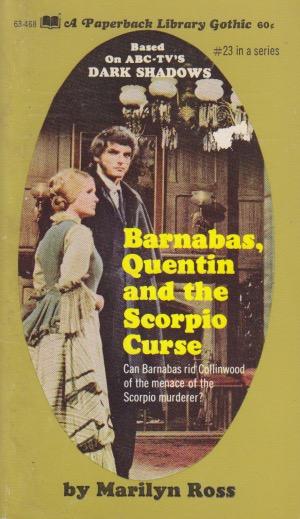
Dark Shadows was a formative part of my childhood. I don’t recall specifics, or even how I found out about it, but I do recall watching it after school and being completely taken by it. When I do the math I realize I had to have been watching it primarily before I was ten, and then after that I started reading the books when I found them in the used bin at the local Goodwill where they usually cost a quarter or less. Now they’re collector’s items. That fact doesn’t change the reality that they are journeyman writing through and through. William Edward Daniel Ross, under the pen name Marilyn Ross, wrote thirty-three novels in the series as part of his oeuvre of over 300 books. The stories are formulaic and feature odd word choices, but they are gothic. Sometimes gothic is just what you need.
Barnabas, Quentin and the Scorpio Curse is a fun romp through a period when Barnabas has—with no explanation in the novel—overcome the vampire curse. It introduces some Collins cousins who come to an asylum conveniently located next door to Collinwood where murder breaks out and mayhem ensues. I have to keep reminding myself to put my critical faculties aside when I read these guilty pleasures. There are gaps and incredulities that are simply glossed over, and that’s part of the world in which they take place. Astrology plays a part in this episode, as the title indicates. It features a psychologist who, it would seem, doesn’t know how to do background checks.
The truly scary part of this Scooby-Doo tale is that the protagonists, Diana and Barnabas Collins, aren’t believed because they’re voluntarily admitted to the asylum. Mental illness is a serious matter, of course, and it can be difficult to diagnose. The difficulty here is that it’s used simply to dismiss what Diana observes. Time and again, as the Scorpio murders continue she’s dismissed as “a mental patient.” It’s all part of a plot, of course. It does raise serious issues, though. In the late sixties and early seventies there was a real stigma attached to mental illness. There still is, in fact. Ironically, the more we learn about mental disorders the more common they become. Just about everyone has some neurosis or worse. In our efforts to define the “normal” we dismiss those with actually diagnosed conditions. We’ve come a long way since then, but we still need to work at dispelling the stigma. One way to do it is, I suppose, to put conflicted vampires into the mix.
